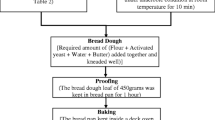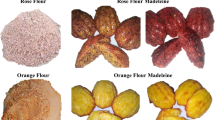Abstract
Fruits and vegetables are extensively processed and the residues are often discarded. However, due to their rich composition, they could be used to minimize food waste. This study aimed to develop food products based on the solid residue generated from the manufacture of an isotonic beverage. This beverage was produced based on integral exploitation of several fruits and vegetables: orange, passion fruit, watermelon, lettuce, courgette, carrot, spinach, mint, taro, cucumber and rocket. The remaining residue was processed into flour and its functional properties were evaluated. The fruit and vegetable residue (FVR) flour was incorporated with different levels (20 to 35 %) into biscuits and cereal bars. The proximate composition, microbiological stability until 90 days and consumer acceptance were analyzed. The FVR flour presented a higher water holding capacity than oil holding capacity, respectively 7.43 and 1.91 g g−1 of flour, probably associated with its high levels of carbohydrates (53 %) and fibres (21.5 %). Biscuits enriched with 35 % of FVR flour presented significantly higher fibre, ranging from 57 % to 118 % and mineral contents, from 25 % to 37 % than when only 20 % was added. Cereal bars presented about 75 % of fibres and variable mineral contents between 14 % and 37 %. The incorporation of FVR did not change the fat content. The microbiological examinations are within acceptable limits according to international regulation. The incorporation of FVR flour did not impair consumer acceptance, the sensory attributes averaged around 6. The chemical, microbiological and sensorial results of the designed products attested for an alternative towards applying and reducing agro-industrial wastes.


Similar content being viewed by others
Abbreviations
- FVR:
-
Fruit and vegetable residue
- OHC:
-
Oil holding capacity
- TTA:
-
Total titratable acidity
- WHC:
-
Water holding capacity
- WF:
-
Wheat flour
References
Abdul-Hamid A, Luan SY (2000) Functional properties of dietary fibre prepared from defatted rice bran. Food Chem 68:15–19
Ajila CM, Naidu KA, Bhat SG, Rao UP (2007) Bioactive compounds and antioxidant potential of mango peel extract. Food Chem 105:982–988
Ajila CM, Leelavathi K, Rao U (2008) Improvement of dietary fiber content and antioxidant properties in soft dough biscuits with the incorporation of mango peel powder. J Cereal Sci 48:319–326
Ajila CM, Aalami M, Leelavathi K, Rao U (2010) Mango peel powder: A potential source of antioxidant and dietary fiber in macaroni preparations. Innov Food Sci Emerg Technol 11:219–224
Anderson RA (1982) Water absorption and solubility and amylograph characteristics of roll-cooked small grain products. Cereal Chem 59:265–269
AOAC (1984) Official methods of analysis, 14th edn. Association of Official Analytical Chemists, Washington DC
Arogba SS (1997) Physical, chemical and functional properties of nigerian mango (mangifera indica) kernel and its processed flour. J Sci Food Agric 73:321–328
Arogba SS (1999) The performance of processed mango (mangifera indica) kernel flour in a model food system. Bioresour Technol 70:277–281
Ayala-Zavala JF, Rosas-Domínguez C, Vega-Vega V, González-Aguilar GA (2010) Antioxidant enrichment and antimicrobial protection of fresh-cut fruits using their own by-products: Looking for integral exploitation. J Food Sci 75:175–181
Ayala-Zavala JF, Vega-Vega V, Rosas-Dominguez C, Palafox-Carlos H, Villa-Rodriguez JA, Siddiqui MW, Davila-Avina JE, Gonzalez-Aguilar GA (2011) Agro-industrial potential of exotic fruit byproducts as a source of food additives. Food Res Int 44:1866–1874
Aziz NAA, Ho L-H, Azahari B, Bhat R, Cheng L-H, Ibrahim MNM (2011) Chemical and functional properties of the native banana (musa acuminata x balbisiana colla cv. Awak) pseudo-stem and pseudo-stem tender core flours. Food Chem 128:748–753
Aziz NAA, Wong LM, Bhat R, Cheng LH (2012) Evaluation of processed green and ripe mango peel and pulp flours (mangifera indica var. Chokanan) in terms of chemical composition, antioxidant compounds and functional properties. J Sci Food Agric 92:557–563
Betoret E, Betoret N, Vidal D, Fito P (2011) Functional foods development: Trends and technologies. Trends Food Sci Technol 22:498–508
Bhardwaj RL, Pandey S (2011) Juice blends- a way of utilization of under-utilized fruits, vegetables, and spices: A review. Crit Rev Food Sci Nutr 51:563–570
Borba AM, Sarmento SBS, Leonel M (2005) Effect of extrusion parameters on sweet potato extrudates. Cienc Tecnol Aliment 25:835–843
Brasil (2001) Regulamento técnico sobre os padrões microbiológicos para alimentos—rdc nº 12, de 2 de janeiro de 2001. Agência Nacional de Vigilância Sanitária
Brouns F, Kovacs E (1997) Functional drinks for athletes. Trends Food Sci Technol 8:414–421
CAC (1997) Principles for the establishment and application of microbiological criteria for foods, vol 1B. Codex alimentarius commission. Joint FAO/WHO Food Standards Programme, Codex Committee on Food Hygiene
Canett-Romero R, Ledesma-Osuna AI, Robles-Sánchez RM, Morales-Castro R, León-Martínez L, León-Gálvez R (2004) Characterization of cookies made with deseeded grape pomace. Arch Latinoam Nutr 54:93–99
Carle R, Schieber A (2006) Functional food components obtained from waste of carrot and apple juice production. Gewinn Funct Lebensm Restst Karottensaft 53:348–352
Chen H, Rubenthaler GL, Leung HK, Baranowski JD (1988) Chemical, physical, and baking properties of apple fiber compared with wheat and oat bran. Cereal Chem 65:244–247
Dominguez-Perles R, Moreno DA, Carvajal M, Garcia-Viguera C (2011) Composition and antioxidant capacity of a novel beverage produced with green tea and minimally-processed byproducts of broccoli. Innov Food Sci Emerg Technol 12:361–368
Downes FP, Ito K (2001) Compendium of methods for the microbiological examination of foods, 4th edn. American Public Health Association, Washington, DC
Figuerola F, Hurtado ML, Estevez AM, Chiffelle I, Asenjo F (2005) Fibre concentrates from apple pomace and citrus peel as potential fibre sources for food enrichment. Food Chem 91:395–401
Gonçalves ECBA (2009) Análise de alimentos: Uma visão química da nutrição, 2nd edn. Varela, São Paulo
Gustavsson J, Cederberg C, Sonesson U, Van Otterdijk RAM (2011) Global food losses and food waste: Extent, causes and prevention. Food and Agriculture Organization of the United Nations (FAO), Rome
Heywood AA, Myers DJ, Bailey TB, Johnson LA (2002) Functional properties of low-fat soy flour produced by an extrusion-expelling system. Am Oil Chem Soc 79:1249–1253
ICMSF (1986) Microorganisms in foods. Sampling for microbiological analysis: Principles and specific applications. International commission on microbiological specifications for foods. Blackie Academic & Professional, London
Kumari S, Grewal RB (2007) Nutritional evaluation and utilization of carrot pomace powder for preparation of high fiber biscuits. J Food Sci Technol 44:56–58
Laufenberg G, Kunz B, Nystroem M (2003) Transformation of vegetable waste into value added products: (a) the upgrading concept; (b) practical implementations. Bioresour Technol 87:167–198
Madruga MS, Camara FS (2000) The chemical composition of “Multimistura” As a food supplement. Food Chem 68:41–44
Martins RC, Chiapetta SC, Paula FD, Gonçalves ECBA (2011) Evaluation isotonic drink fruit and vegetables shelf life in 30 days. Braz J Food Nutr 22:623–629
Nilnakara S, Chiewchan N, Devahastin S (2009) Production of antioxidant dietary fibre powder from cabbage outer leaves. Food Bioprod Process 87:301–307
Noor Aziah A, Komathi CA (2009) Acceptability attributes of crackers made from different types of composite flour. Int Food Res J 16:479–482
Pesquisa de orçamentos familiares - aquisição alimentar domiciliar per capita brasil e grandes regiões (2008) Instituto Brasileiro de Geografia e Estatística. http://www.ibge.gov.br/home/estatistica/populacao/condicaodevida/pof/default.shtm. Accessed 19 February 2013
Rosales Soto MU, Brown K, Ross CF (2012) Antioxidant activity and consumer acceptance of grape seed flour-containing food products. Int J Food Sci Technol 47:592–602
Schieber A, Stintzing FC, Carle R (2001) By-products of plant food processing as a source of functional compounds - recent developments. Trends Food Sci Technol 12:401--413
Silva RF, Ascheri JLR (2009) Extrusion of broken rice for use as food ingredient. Braz J Food Technol 12:190–199
Silva IQ, Oliveira BCF, Lopes AS, Pena RS (2009) Cereal bar with the industrial residue of passion fruit. Braz J Food Nutr 20:321–329
Sousa MSB, Vieira LM, Da Silva MJM, De Lima A (2011) Nutritional characterization and antioxidant compounds in pulp residues of tropical fruits. Cienc Agrotecnol 35:554–559
Stone H, Sidel JL (1992) Sensory evaluation practices, 2nd edn. Academic, San Diego
Sun-Waterhouse D (2011) The development of fruit-based functional foods targeting the health and wellness market: A review. Int J Food Sci Technol 46:899–920
Sun-Waterhouse D, Wen I, Wibisono R, Melton LD, Wadhwa S (2009) Evaluation of the extraction efficiency for polyphenol extracts from by-products of green kiwifruit juicing. Int J Food Sci Technol 44:2644–2652
Sun-Waterhouse D, Teoh A, Massarotto C, Wibisono R, Wadhwa S (2010) Comparative analysis of fruit-based functional snack bars. Food Chem 119:1369–1379
Yagci S, Gogus F (2009) Development of extruded snack from food by-products: A response surface analysis. J Food Process Eng 32:565–586
Zaror CA (1992) Controlling the environmental impact of the food industry: An integral approach. Food Control 3:190–199
Acknowledgments
The authors thank the Brazilian funding institute CAPES (Coordination for the Improvement of Higher Education Personnel) for the financial support.
Author information
Authors and Affiliations
Corresponding author
Rights and permissions
About this article
Cite this article
Ferreira, M.S.L., Santos, M.C.P., Moro, T.M.A. et al. Formulation and characterization of functional foods based on fruit and vegetable residue flour. J Food Sci Technol 52, 822–830 (2015). https://doi.org/10.1007/s13197-013-1061-4
Revised:
Accepted:
Published:
Issue Date:
DOI: https://doi.org/10.1007/s13197-013-1061-4




